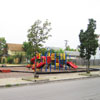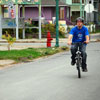Active Commuting in the Sweet Home Central School District 2013-2015
This project aimed to improve the rates of active commuting among school children in the suburban town of Amherst, New York. With support from the UB Food Lab team and collaborating faculty, the town of Amherst deployed four strategies to promote active commuting in the Sweet Home Central School District in the town. These strategies included providing education on active commuting (e.g. by distributing lesson plans and conducting assemblies), encouraging active commuting (e.g. by providing Walk to School route maps, and organizing Walk/Bike to School Day), enforcing laws to create a safer walking environment (e.g. enforcing traffic rules to create a safe walking/biking environment), and engineering the built environment to make it walkable (eg. through modifications to the built environment).
The Food Lab team also conducted a pre-post evaluation to document the impact of these efforts. Evaluation methods included use of parent surveys, classroom tallies of student commuters, and open-ended interviews with parents to determine how the active commuting patterns of the students changed as a result of the effort. Results are available through academic publications and a practitioner-friendly report that provides recommendations for promoting active commuting in the Sweet Home Central School District. Recommendations including creating and celebrating a culture of active commuting within the school district, developing a ‘Healthy Living’ zone within a ¼ mile of the elementary school to promote walking and biking and reducing busing within the healthy living zone, and developing culturally relevant educational materials for children and their families.
. View the report here: Moving Together: Promoting Active Commuting To School in Sweet Home Central School District and the Town of Amherst, New York
Influence of Built Environment of Physical Activity of Youth
 The UB Food Lab team conducts research on the impact of the physical (built) environment in enabling or constraining physical activity among youth. In partnership with the UB School of Medicine, the lab team has documented the ways in which neighborhood design impacts children’s physical activity as well as how the design features within parks impact children’s levels and choices of physical activity. This research uses both perceptual and objective data measured using surveys, accelerometers, Global Positioning Systems (GPS), and Geographic Information systems (GIS). This research is made possible in part by the National Institute of Health, the Robert Wood Johnson Foundation, and a grant from the University at Buffalo’s 3E Initiative.
The UB Food Lab team conducts research on the impact of the physical (built) environment in enabling or constraining physical activity among youth. In partnership with the UB School of Medicine, the lab team has documented the ways in which neighborhood design impacts children’s physical activity as well as how the design features within parks impact children’s levels and choices of physical activity. This research uses both perceptual and objective data measured using surveys, accelerometers, Global Positioning Systems (GPS), and Geographic Information systems (GIS). This research is made possible in part by the National Institute of Health, the Robert Wood Johnson Foundation, and a grant from the University at Buffalo’s 3E Initiative.
Work Environmental Design and Physical Activity Study 2007-2017
 The design of the built environment – specifically, the design, diversity, and density of urban environments – are reported to be associated with levels of physical activity of the inhabitants. A small body of scholarship has examined the role of quality of work environments – such as medical campuses – on the physical activity rates of employees. In 2007, the Buffalo Niagara Medical Campus and the UB Food Lab initiated a two-phased (pre-post research design) study to evaluate the ways in which improvements to the built environment and infrastructure of a work campus might impact the physical activity of employees. The first phase and pre-test data collection was completed before the design and construction of Ellicott Street. The redesign and construction of Ellicott Street is now complete and there is now an opportunity to document the impact of the improvements made on the campus on the quality of work life of employees. Phase two evaluation of the project is occurring nearly 10 years after baseline data collection was completed.
The design of the built environment – specifically, the design, diversity, and density of urban environments – are reported to be associated with levels of physical activity of the inhabitants. A small body of scholarship has examined the role of quality of work environments – such as medical campuses – on the physical activity rates of employees. In 2007, the Buffalo Niagara Medical Campus and the UB Food Lab initiated a two-phased (pre-post research design) study to evaluate the ways in which improvements to the built environment and infrastructure of a work campus might impact the physical activity of employees. The first phase and pre-test data collection was completed before the design and construction of Ellicott Street. The redesign and construction of Ellicott Street is now complete and there is now an opportunity to document the impact of the improvements made on the campus on the quality of work life of employees. Phase two evaluation of the project is occurring nearly 10 years after baseline data collection was completed.